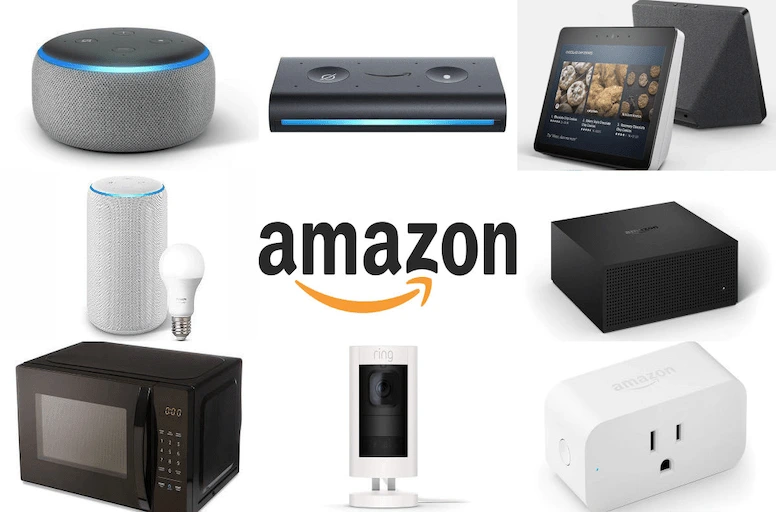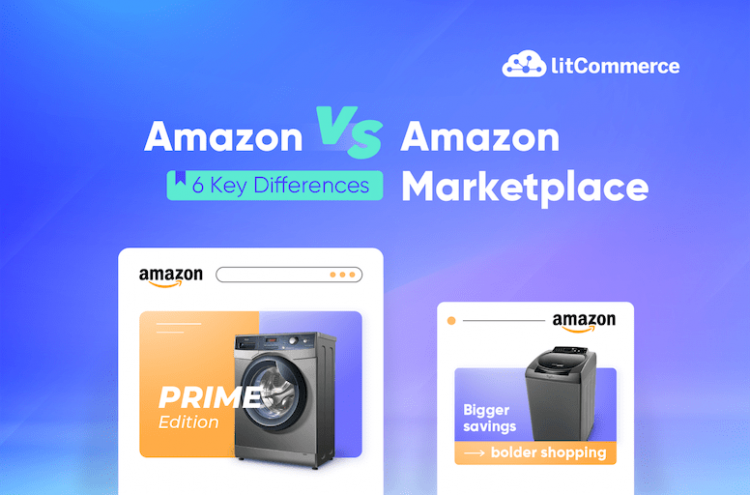Is Amazon Marketplace The Same As Amazon?
No, it isn’t. As a matter of fact, it is challenging to fully distinguish Amazon vs Amazon Marketplace since these two are closely integrated into one another. Not to mention the differences, Amazon lets online merchants take advantage of its great brand reputation and excessive monthly traffic of 2.3 billion. For many sellers, these figures are good reasons to learn how to sell on Amazon.
However, will you have access to these benefits when Amazon and Amazon Marketplace are indeed differentiated from one another? Apparently, the dilemma must be provoking to third-party sellers on Amazon and raise one big question: What is the difference between Amazon and Amazon Marketplace?
If you find yourself figuring out this case, you’ve landed in the right spot. In the following sections, LitCommerce will walk you through 6 key differences between Amazon vs Amazon Marketplace, including:
- General platform features
- Products
- Seller fees
- Inventory source and management
- Fulfillment and shipping
- Returns and customer service
Let’s get the ball rolling!
Expand Beyond Amazon Today with LitCommerce
The good news is you can easily expand to the most dynamic selling sites once you go live on Amazon. Try the LitCommerce Multichannel Sync tool and unlock new eCommerce potential now!
Amazon vs Amazon Marketplace: The Very Basic
Before we delve into our Amazon Marketplace vs Amazon in-depth comparison, let’s get to know the highlights of both sides. In this section, we will cover two main points:
- What is Amazon?
- What is Amazon Marketplace?
What is Amazon?

Amazon is a top online marketplace for both individuals and businesses, and it is available in a variety of countries and languages.
Founded in 1994 by Jeff Bezos, Amazon began as a simple online bookstore. Amazon has grown from humbly beginning to redefining the whole landscape of eCommerce as one of the best-selling platforms. Needless to say, Amazon is one of the top marketplaces, but is it still worth it to sell on Amazon marketplaces in 2024? The answer is yes. Check out our latest Amazon review for more details.
Recently, Amazon has extended its product and service offerings. In addition, it has entered the streaming video industry, the cloud computing marketplace, and, most recently, the banking industry.
Currently, Amazon allows people and businesses to sell and display almost everything online with powerful eCommerce tools. Speaking of which, some of the most popular eCommerce toolsets for online merchants on Amazon include:
What is Amazon Marketplace?
Continuing our topic of Amazon vs Amazon Marketplace, let’s talk about Amazon Marketplace. In short, the Amazon Marketplace is a marketplace for third-party sellers that is incorporated into the same platform as Amazon. Particularly, this marketplace provides users with a considerably large product selection from thousands of external merchants, as well as the ability to compare prices to keep the platform competitive.
Many buyers are unaware that they are purchasing from third-party merchants since Amazon Marketplace is so tightly integrated into Amazon.com. There’s a good reason for this, and you’ll begin to understand why further along in the article.
As a fact, Amazon.com is quite picky about who they allow to sell on Amazon Marketplace. Only a few nations are permitted to participate, and sellers must have financial accounts in those jurisdictions.
6 Key Differences Between Amazon vs Amazon Marketplace
Here comes the most thrilling part of our comparison. In the upcoming sections, LitCommerce is going to cover 6 major differences between Amazon.com vs Amazon Marketplace.
For now, let’s not keep you waiting any longer and analyze these 5 aspects!
#1. General platform features
Although both Amazon and Amazon Marketplace are almost unified, there are several differences in terms of platform features and orientation. Here are our detailed explanations.

Amazon’s general characteristics
First and foremost, Amazon is a massive online retailer and cloud service provider. On the first hand, Amazon has evolved from a humble online bookstore to a multi-million dollar retailing empire. Up to this point, Amazon has leveraged its value as an online retailer by innovating a customer-centric approach, technology, and global reach. In accordance with that, Amazon has built a vast customer base by operating multiple marketplaces worldwide.
Speaking more about the term cloud service provider, Amazon is pretty famous for its AWS (Amazon Web Services). Within the services provided by Amazon, you might have heard of Amazon Elastic Compute Cloud (EC2) or Amazon Simple Storage Service (S3). Apart from that, Amazon reputes numerous other machine learning, database processing, and computing powering services.
Above all, Amazon defines itself as a customer-oriented online retailer and service provider. In other words, Amazon evolves around customers to provide them with tangible or intangible products and services. This also means that the customer journey and experience of Amazon vs Amazon Marketplaces are completely different, which will come in detail later.
Amazon Marketplace’s general characteristics
Unlike Amazon, Amazon Marketplace is a third-party retail market that is tightly integrated with Amazon. Simply put, Amazon Marketplace lets third-party sellers list and sell their products to end-users or online customers. Based on this ground, Amazon Marketplace is more of a seller service provider.
Furthermore, Amazon Marketplace defines itself as seller-oriented, which stays in contrast with Amazon. As a seller service provider, Amazon Marketplace focuses on helping sellers promote and sell their products through an Internet platform for a set price.
A fact you might not know: Third-party sellers make more than half of Amazon’s total sales revenue.
Verdict: One major difference between Amazon and Amazon Marketplace surely comes from their basic characteristics. While Amazon focuses on customers and evolves around customer needs over time, Amazon Marketplace approaches as a seller service provider.
#2. Products

Next on comparing Amazon vs Amazon Marketplace, let’s come to their products. On the one hand, product ranges on Amazon retail vs Amazon Marketplace don’t vary much from each other. Both have gone to extended lengths, which include beauty products, electronics, and almost anything else to achieve desired sales revenue.
On the other hand, there are two significant differences between products on Amazon.com vs Amazon Marketplace, explained as follows.
- Amazon’s products: Whatever products are sold on Amazon, they belong to the Amazon brand and come as 100% new. Also, Amazon products are pretty much eligible for Amazon Prime benefits, while the case isn’t the same for every product belonging to Amazon Marketplace.
- Amazon Marketplace’s products: Conversely, Amazon Marketplace’s products aren’t always owned by a brand. However, don’t mistake that there are no brands on Amazon Marketplace. Brands still make the most dynamic sellers on this sales channel. On top of that, they can be identified as New or Used, following Amazon Product Guidelines. One more thing is that Amazon Marketplace’s products won’t always get qualified for Amazon Prime benefits, as aforementioned.
Finally, it’s worth noting that product information will include universal product codes, or UPCs, which are labeled on packaging to aid in item identification. Amazon reserves the right to remove listings that do not match the criteria for authentic UPC codes.
Notes: When it comes to products in general, you might be interested in getting to know the best products to sell on Amazon and make your sales faster.
Verdict: Products on Amazon vs Amazon Marketplace don’t vary much, except that Amazon’s products must be 100% new and branded. They are also more eligible for Amazon Prime benefits, while the case isn’t the same for Amazon Marketplace’s sold items.
Sell Your Best Products on Amazon and More!
Why limit your selling potential by listing products on one channel? Try out the LitCommerce Multichannel Sync tool and start selling on Amazon and 20+ dynamic marketplaces now!
#3. Seller fees

Coming to the third aspect of the Amazon vs Amazon Marketplace comparison, it’s time to talk about seller fees. Keep scrolling through and get a grasp of Amazon Marketplace vs Amazon.com charge right below.
- Amazon seller fees include Individual and Professional plans.
For those with an Individual plan, Amazon does not charge a monthly subscription. Nonetheless, they have to pay a commission of $0.99 per item sold. On the other hand, sellers with a Professional plan get charged $39.99 monthly as a subscription. Yet, they don’t have to pay a commission per sale anymore.
These are two major seller charges by Amazon.com. Additional fees, such as advertising, will get added if sellers implement any action or campaign during their selling experience with Amazon. Also, keep in mind that Amazon stores don’t usually pay for FBA because they are all baked up with warehouse and shipping support by Amazon already.
- Amazon Marketplace’s seller fees
Apart from registering and paying for one of the two pricing tiers mentioned, Amazon Marketplace third-party sellers also pay:
- Closing fees (applied to media products);
- FBA fees (if in use);
- Referral fees, and more.
Verdict: From our viewpoint, Amazon has a less complex fee structure and is occasionally more affordable than that of Amazon Marketplace. Hence, in terms of Amazon.com vs Amazon Marketplace charge, Amazon has got a winning point.
#4. Inventory source and management

Here comes the 4th key difference between Amazon Marketplace and Amazon.com – inventory source and management. Now, let’s get to the detail!
- Amazon’s inventory source and management: When it comes to inventory, remember that Amazon owns its inventory. Besides, since Amazon is an online retailer itself, all inventory management is on the house. In other words, if a customer purchases on Amazon, they buy products distributed directly from the house’s inventory.
- Amazon Marketplace’s inventory source and management: The inventory aspect of Amazon Marketplace vs Amazon.com is completely different. Unlike Amazon, Amazon Marketplace doesn’t own or manage any inventory. As Amazon Marketplace is 100% devoted to providing seller services, third-party sellers are those who own and manage inventory.
Verdict: The difference between Amazon vs Amazon Marketplace regarding inventory is evident. Amazon owns and manages its own inventory while Amazon Marketplace simply facilitates a shopping-selling environment.
#5. Fulfillment and shipping

More on Amazon vs Amazon Marketplace analysis, it is essential to fully understand the difference between these two, considering fulfillment and shipping.
- Amazon’s fulfillment and shipping: Amazon has implemented several shipping and fulfillment services, among which FBA (Fulfillment by Amazon) stands out. Aside from that, other programs, including Seller-Fulfilled Prime Amazon Easy Ship, offers fast shipping as well. Surprisingly, they also let sellers have more control over the general shipping and fulfillment procedures, given that sellers must be qualified for these programs.
- Amazon Marketplace’s fulfillment and shipping: When participating in Amazon Marketplace, sellers can make use of FBM (Fulfillment by Merchants), 3PL services (Third-party Logistic), and Amazon Hybrid Approach (a combination of FBM and 3PL services). Considering this matter, Amazon Marketplace sellers have quite a plenty of fulfillment and shipping services by choice.
Verdict: In the match of Amazon vs Amazon Marketplace fulfillment and shipping, both sides get a point for their variety of choices for sellers.
#6. Returns and customer service

The 6th section in our Amazon vs Amazon Marketplace analysis gets down to returns and customer service. This is also the last part of our answer to the raised question: What is the difference between Amazon.com vs Amazon Marketplace? Let’s dive into it!
- Amazon’s returns and customer service: Amazon has a set of return policies for customers, which adapt to friendliness, fairness, and support. The Amazon return policies come in detail for each purchase section from physical to digital items. This also goes with a professional customer service team to assure the highest level of customer satisfaction.
- Amazon Marketplace’s returns and customer service: Returns and customer services on Amazon Marketplace are 100% handled by third-party sellers. In accordance with Amazon return policies, sellers may set additional rules for a return or refund, based on their product types. Within return and refund policies, Amazon offers both sellers and buyers an A-to-Z Guarantee program, aiming at resolving complex cases fairly and quickly.
Verdict: Both Amazon and Amazon Marketplace have different resolutions for returns and customer service. However, customer service quality on Amazon Marketplace might not always be as consistent as that on Amazon.com.
Amazon vs Amazon Marketplace: FAQs
- 1. Is it Worth Selling on Amazon Marketplace?
Yes, selling on Amazon Marketplace is worth it! Selling on Amazon Marketplace can be challenging but extremely rewarding.
In fact, the good news is that many companies selling on Amazon can be extremely successful. This is because they have the proper products, clever marketing strategies, tools, and customer support. Despite the fact that there is strong competition in practically every category of the market, there are still lots of opportunities for companies to succeed.
- 2. Are Amazon and Amazon Marketplace the same?
No, Amazon and Amazon Marketplace are not the same. Here are 6 key differences between Amazon vs Amazon Marketplace:
- General platform features: Amazon is customer-central and makes an online retailer as well as a service provider itself. Meanwhile, Amazon Marketplace approaches as a seller service provider.
- Products: They both have quite similar product ranges. However, only new and products with a brand are allowed to sell on Amazon. Amazon Marketplace allows both new and used, brand and non-brand items.
- Seller fees: Amazon has a less complex fee structure than Amazon Marketplace.
- Inventory source and management: Amazon owns and manages its inventory, but Amazon Marketplace doesn’t.
- Fulfillment and shipping: Both have a variety of fulfillment and shipping choices.
- Returns and customer service: Amazon has a direct return policy and a customer support team. Amazon Marketplace’s returns can vary, and customer service is handled individually by sellers.
- 3. How safe is Amazon Marketplace?
Amazon Marketplace is safe, secure, and guaranteed. It provides you with a convenient method of payment and is the only authorized and recognized form of payment on Amazon. You should never pay for a Marketplace item outside of Amazon.
- 4. What makes Amazon a marketplace?
The Amazon Marketplace is a marketplace for third-party sellers that is incorporated into the same platform as Amazon.
This marketplace provides users with a considerably large product selection from thousands of external merchants, as well as the ability to compare prices to keep the platform competitive.
- 5. Why Amazon Marketplace is the best?
Amazon Marketplace is one of the best selling channels because of its massive audience, various selling toolsets, flexible shipping, and order fulfillment methods, as well as incredible advertising opportunities. By having the right products and implementing winning eCommerce strategies, you can streamline a great second income from Amazon Marketplace.
Amazon vs Amazon Marketplace: Final Words
To conclude, we’ve just shown you the differences between Amazon vs Amazon Marketplace in terms of 6 key aspects:
- General characteristics
- Products
- Seller fees
- Inventory source and management
- Fulfillment and shipping
- Returns and customer service
To our belief, Amazon poses massive advantages that any business should take into consideration. There’s no should or shouldn’t advice, it depends all on your effort and wise strategies to make your business thrive.
In case you want to consider an Amazon integration that can easily connect your main store to Amazon Marketplace, you should give LitCommerce a try! This is the most flexible multi-channel solution which can bring your products to the top global marketplaces like eBay, Etsy, Walmart, and far more. Don’t hesitate to contact the customer support team if you have any questions. They’re always willing to help.
Lastly, stay tuned to our Retailers Blog for more eCommerce growth hacks to thrive like never before!




